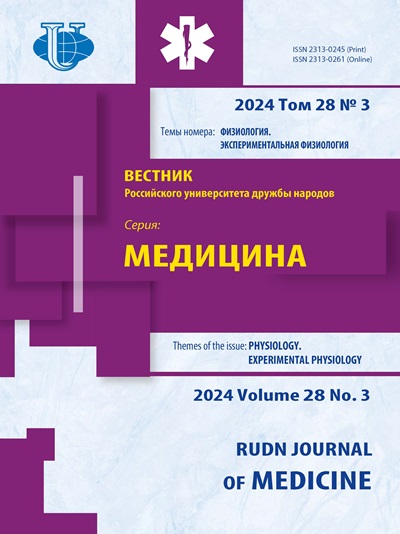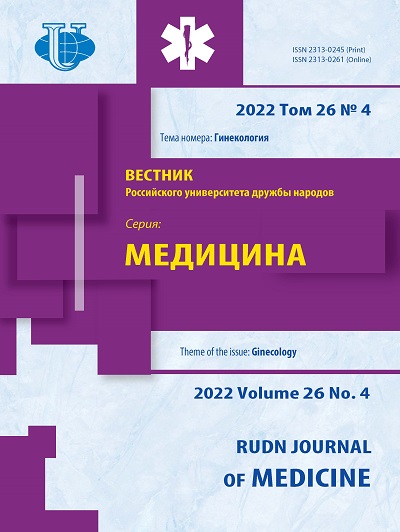Immunotherapy at the modern stage: types and tactics of application
- Authors: Korzhenevsky A.A.1,2, Korzhenevskaya N.P.1
-
Affiliations:
- Republican Clinical Hospital named after G.G. Kuvatov
- Bashkir State Medical University
- Issue: Vol 26, No 4 (2022): GINECOLOGY
- Pages: 404-421
- Section: IMMUNOLOGY
- URL: https://journals.rudn.ru/medicine/article/view/32994
- DOI: https://doi.org/10.22363/2313-0245-2022-26-4-404-421
Cite item
Full Text
Abstract
The sum of the effects of all negative factors on the human body is manifested, including in the form of an imbalance in the work of the immune system, which leads to a violation of the recognition and elimination of foreign substances of the most diverse origin. This is manifested in an increase in the frequency of development of inflammatory processes, the risk of their chronicity and the development of complications, the identification of opportunistic or conditionally pathogenic flora as a pathogen, including those with atypical biological properties and antibiotic resistance. The use of etiotropic chemotherapy alone in the treatment does not allow achieving sufficient control over many infectious diseases. The purpose of this review was to investigate additional, alternative approaches to influencing anti-infective immunity. An analysis of the strategy based on the use of modulation of the immune response in the treatment of patients was carried out and its advantages over traditional antimicrobial treatment were determined. The concept of «immunotherapy» is discussed, which implies a variety of effects on the immune system in order to stop the pathological process. The review highlights the main types of immunotherapy - local, general, combined and monoimmunotherapy, as well as active and passive, specific and nonspecific. The review provides convincing data on the need for immunomodulators to meet a number of requirements, analyzes various ways of classifying them and their areas of application. The necessity of using immunotropic drugs on the basis of a comprehensive examination is emphasized, taking into account the correspondence between the nature of clinical manifestations and the severity of changes in immunological parameters. The analyzed data allow us to conclude that immunomodulatory therapy can be used to restore the function of the immune system to the physiological norm after a severe inflammatory process at the stage of immunorehabilitation.
Keywords
About the authors
Alexey A. Korzhenevsky
Republican Clinical Hospital named after G.G. Kuvatov; Bashkir State Medical University
Author for correspondence.
Email: koral@ufanet.ru
ORCID iD: 0000-0002-8758-7822
Ufa, Russian Federation
Nina P. Korzhenevskaya
Republican Clinical Hospital named after G.G. Kuvatov
Email: koral@ufanet.ru
ORCID iD: 0000-0002-6388-7257
Ufa, Russian Federation
References
- Mihaylova NA. Features of clinical trials of immunomodulatory drugs of bacterial origin. In: Guidelines for clinical trials of drugs (immunobiological drugs). Part II. Moscow: Grif i K. 2012:196—9. (In Russian).
- On the state sanitary and epidemiological welfare of the population in the Russian Federation in 2012. State report. Moscow: Federal Service for Supervision of Consumer Rights Protection and Human Welfare. 2013. (In Russian).
- Korotkaja NA, Mishinov SV, Stupak VV, Tyrinova TV, Leplina OJu, Ostanin AA, Chernyh ER. Combined immunotherapy in the treatment of glial brain tumors. Modern problems of science and education. 2017;6. (In Russian).
- Polevshhikov AV, Rjazancev SV. Advantages of local immunotherapy in the treatment and prevention of rhinopharyngitis. The attending physician. 2002;7—8:68—70. (In Russian).
- Nemirovskaya TI, Kovtun VP, Abramtseva MV, Alexandrova NV, Tarasov AP, Salakhova RD, Volkov VA, Merkulov VA. Immunomodulators of bacterial origin registered in the Russian Federation. Biopreparation (Biopharmaceuticals). 2014;3:19—26. (In Russian).
- Haitov RM, Pinegin BV. Modern immunomodulators. Classification. The mechanism of action. Moscow: Farmrus Print. 2005:27 р. (In Russian).
- Afinogenova VP, Lukachev IV, Kostinov MP. Immunotherapy: mechanism of action and clinical use of immunocorrecting drugs. The attending physician. 2010;4:9. (In Russian).
- Fjodorov JuN, Kljukina VI, Romanenko MN, Bogomolova OA, Denisenko AN. Strategy and principles of immunocorrection and immunomodulating therapy. Vestnik NovGU. 2015;86:84—86. (In Russian).
- Baxevanis CN., Perez SA., Papamichail M. Cancer immunotherapy. Crit Rev Clin Lab Sci. 2009;46(4):167—189.
- Zhou J. Advances and prospects in cancer immunotherapy. New Journal of Science. 2014:1—13.
- Raval RR, Sharabi AB, Walker AJ, Drake CG, Sharma P. Tumor immunology and cancer immunotherapy: summary of the 2013 SITC primer. J Immunother Cancer. 2014;2:14. doi: 10.1186/2051-1426-2-14
- Harada N, Ito J, Takahashi K. Clinical effects and immune modulation of biologics in asthma. Respir Investig. 2021;59(4):389 doi: 10.1016/j.resinv.2021.03.003
- Gandhi NA, Pirozzi G, Graham NMH. Commonality of the IL-4/IL-13 pathway in atopic diseases. Expert Rev Clin Immunol. 2017;13(5):425—437. doi: 10.1080/1744666X.2017.1298443
- Nenasheva NM. Severe eosinophilic bronchial asthma: new therapeutic options. Meditsinskiy sovet Medical Council. 2018;15:44—52. (In Russian).
- Merzlyak EM, Syrko DS, Musatkina EA, Israelson MА. The use of monoclonal antibodies in autoimmunity treatment. Vestnik RGMU.RU. 2018;6(4):164—169. doi: 10.24075/brsmu.2018.094 (In Russian).
- Karaulov AV, Kokushkov DV. Immunomodulators: classification, principles and practice of respiratory infections in children. Children Infections. 2007;6(4):268—70. (In Russian).
- Novikova IA. Secondary Immunodeficiency: clinic-laboratory diagnostics (lecture). Problems of health and ecology. 2009;1(19):29— 34. (In Russian).
- Namazova-Baranova LS, Gankovskaja LV, Astaf’eva NG. Fundamentals of Clinical Immunology and Allergology: textbook. Moscow: Pediatr. 2016:152 р. (In Russian).
- Bulgakova VA. On issue of immune modulators application in therapy and prevention of respiratory viral infections in children. Meditsinskiy sovet. 2016;17:56—61. (In Russian).
- Reviakina VA, Astaf’eva NG, Geppe NA, Kaliuzhin OV. Updated PRIMA consensus document to assist the practicing physician. Pediatrics. Consilium Medicum. 2021;2:109—112. doi: 10.26442/26586630.2021.2.200992 (In Russian).
- Luss LV. Secondary immunodeficiency conditions in children. The clinician’s view on the appointment of immunomodulatory therapy. Allergology and immunology in pediatrics. 2018;4(55):4—18. doi: 10.24411/2500-1175-2018-00017 (In Russian).
- Zhukova SI, Khabarova IA, Toporkov AV. Improving emergency prevention and treatment of dangerous infections using immunomodulators. Astrahanskij medicinskij zhurnal. 2019;14(3):20— 36. doi: 10.17021/2019.14.3.20.36 (In Russian).
- Vishneva EA, Alekseeva AA, Margieva TV, Voznesenskaya NI. Immune-response modulating therapy in children with recurrent respiratory infections. Pediatric Pharmacology. 2011;6:108—113. (In Russian).
- Guryanova SV, Khaitov RM. Glucosaminylmuramyldipeptide — GMDP: effect on mucosal immunity (on the issue of immunotherapy and immunoprophylaxis). Immunologiya. 2020;41(2):174—183. doi: 10.33029/0206-4952-2020-41-2-174-183 (In Russian).
- Kolesnikova NV, Kozlov IG, Guryanova SV, Kokov EA, Andronova TM. Clinical and immunological efficiency of muramyl dipeptide in the treatment of atopic diseases. Medical Immunology. 2016;18(1):15—20. doi: 10.15789/1563-0625-2016-1-15-20 (In Russian).
- Juzhakova DV, Shirmanova MV, Sergeeva TF, Zagajnova EV, Luk’janov KA. Immunotherapy of malignant neoplasms (review). Modern technologies in medicine. 2016;8(1):173—182. (In Russian).
- Shamsheva OV. Vaccination and human health. Childhood infections. 2015;4:6—12. (In Russian).
- Restifo NP, Dudley ME, Rosenberg SA. Adoptive immunotherapy for cancer: harnessing the T cell response. Nat Rev Immunol. 2012;12(4):269—281.
- Schlom J. Therapeutic cancer vaccines: current status and moving forward. J. Natl Cancer Inst. 2012;104(8):599—613. http://dx.doi.org/10.1093/jnci/djs033
- Scott AM, Wolchok JD, Old LJ. Antibody therapy of cancer. Nat Rev Cancer. 2012;12(4):278—287.
- Karaulov AV, Kalyuzhin OV. Immunotherapy of infectious diseases: problems and prospects. Therapeutic Archive. 2013;85(11):100—108. (In Russian).
- Kostinov MP. Fundamentals of immunorehabilitation in new coronavirus infection (COVID-19). A manual for doctors. Moscow: Gruppa MDV. 2020. 111 р. (In Russian).
- Guryanova SV, Kudryashova NA, Kataeva AA, Orozbekova BT, Kolesnikova NV, Chuchalin AG. Novel approaches to increase resistance to acute respiratory infections. RUDN Journal of Medicine. 2021;25(3):181—195. doi: 10.22363/2313-0245-2021-25-3-181-195
















